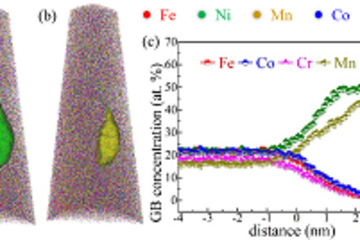All genres
81.
Journal Article
Boron doped ultrastrong and ductile high-entropy alloys. Acta Materialia 151, pp. 366 - 376 (2018)
82.
Journal Article
Strain Rate Sensitivity of a TRIP-Assisted Dual-Phase High-Entropy Alloy. Frontiers in Materials Structural Materials 5 (30), pp. 1 - 10 (2018)
83.
Journal Article
Hydrogen embrittlement of an interstitial equimolar high-entropy alloy. Corrosion Science 136, pp. 403 - 408 (2018)
84.
Journal Article
Influence of compositional inhomogeneity on mechanical behavior of an interstitial dual-phase high-entropy alloy. Materials Chemistry and Physics 210, pp. 29 - 36 (2018)
85.
Journal Article
Corrosion behavior of an equiatomic CoCrFeMnNi high-entropy alloy compared with 304 stainless steel in sulfuric acid solution. Corrosion Science 134, pp. 131 - 139 (2018)
86.
Journal Article
In-situ SEM observation of phase transformation and twinning mechanisms in an interstitial high-entropy alloy. Acta Materialia 147, pp. 236 - 246 (2018)
87.
Journal Article
Unexpected cyclic stress-strain response of dual-phase high-entropy alloys induced by partial reversibility of deformation. Scripta Materialia 143, pp. 63 - 67 (2018)
88.
Journal Article
Engineering heterostructured grains to enhance strength in a single-phase high-entropy alloy with maintained ductility. Materials Research Letters 6 (11), pp. 634 - 640 (2018)
89.
Journal Article
Enhanced strength and ductility in a friction stir processing engineered dual phase high entropy alloy. Scientific Reports 7 (1), 16167 (2017)
90.
Journal Article
Ab initio assisted design of quinary dual-phase high-entropy alloys with transformation-induced plasticity. Acta Materialia 136, pp. 262 - 270 (2017)
91.
Journal Article
Hydrogen enhances strength and ductility of an equiatomic high-entropy alloy. Scientific Reports 7 (1), 9892 (2017)
92.
Journal Article
A TRIP-assisted dual-phase high-entropy alloy: Grain size and phase fraction effects on deformation behavior. Acta Materialia 131, pp. 323 - 335 (2017)
93.
Journal Article
Hydrogen effects on microstructural evolution and passive film characteristics of a duplex stainless steel. Electrochemistry Communucations 79, pp. 28 - 32 (2017)
94.
Journal Article
Strong and Ductile Non-equiatomic High-Entropy Alloys: Design, Processing, Microstructure, and Mechanical Properties. JOM-Journal of the Minerals Metals & Materials Society 69 (11), pp. 2099 - 2106 (2017)
95.
Journal Article
Interstitial atoms enable joint twinning and transformation induced plasticity in strong and ductile high-entropy alloys. Scientific Reports 7, 40704 (2017)
96.
Journal Article
Interfacial Mechanical Behavior and Electrochemical Corrosion Characteristics of Cold-Sprayed and Hot-Rolled Titanium/Stainless-Steel Couples. Advanced Engineering Materials 18 (7), pp. 1240 - 1249 (2016)
97.
Journal Article
Metastable high-entropy dual-phase alloys overcome the strength–ductility trade-off. Nature 534, pp. 227 - 230 (2016)
98.
Journal Article
High-strain induced reverse martensitic transformation in an ultrafine-grained Ti–Nb–Ta–Zr alloy. Philosophical Magazine Letters 96 (5), pp. 189 - 195 (2016)
99.
Journal Article
Mechanical Behavior of Ultrafine-Grained Ti–6Al–4V Alloy Produced by Severe Warm Rolling: The Influence of Starting Microstructure and Reduction Ratio. Metallurgical and Materials Transactions a-Physical Metallurgy and Materials Science 46 (11), pp. 5047 - 5057 (2015)
100.
Book Chapter
Iron-rich High Entropy Alloys. In: High-Performance Ferrous Alloys, pp. 389 - 421 (Ed. Rana, R.). Springer Nature Switzerland, Cham, Switzerland (2021)











